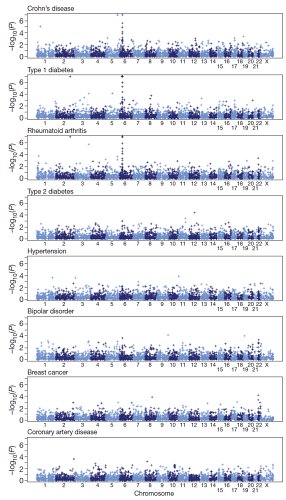CNVs and common disease

A study of the genetics of common diseases including diabetes, heart disease and bipolar disorder has found that commonly occurring copy number variations – duplicated or missing chunks of DNA in our genome – are unlikely to play a major role in such diseases. The research, funded by the Wellcome Trust, is published online today in the journal Nature.
In 2007, the Wellcome Trust Case Control Consortium (WTCCC) published the results of the largest ever study of the genetics of common diseases, revealing for the first time a number of genes which were found to increase the risk of developing certain diseases. Since then, dozens more genes have been found.
Despite the large numbers of genes discovered, scientists are still some way off explaining all of the heritability of the diseases. For example, for type 2 diabetes, there are now around thirty genetic variants known to influence susceptibility to the disease, but these only account for about 10 per cent of the known inherited risk of developing these conditions.
One theory for this so-called ‘missing heritability’ was that it may have been caused by copy number variations (CNVs). These mainly occur when copies of the genome are passed down from parent to child. Just as mutations in the genome can give rise to different forms of genes, so whole segments of the genome may end up being duplicated or deleted – these are known as CNVs. CNVs have already been found to cause disease in rare cases, however. For example, deletions of part of chromosome 16 have previously been shown to lead to severe obesity from a young age.
Researchers from the WTCCC analysed common CNVs in DNA samples from 3,000 healthy volunteers and compared them to 16,000 patients – 2,000 each with bipolar disorder, breast cancer, coronary artery disease, Crohn’s disease, hypertension, rheumatoid arthritis, type 1 diabetes and type 2 diabetes respectively.
The team identified and confirmed three loci (genetic regions) that contained a commonly occurring CNV and were also associated with common disease. However, all three loci had been identified previously by searching for changes in single letters of the DNA code (known as single nucleotide polymorphisms, or ‘SNPs’); by comparison, this technique, used in the original WTCCC study, identified twenty-four genetic loci. None of the three CNV loci is believed to be a ‘functional variant’ – in other words, it is unlikely that they contribute to disease.
“It seems unlikely that common CNVs play a major role in the genetic basis of common diseases, either through particular CNVs having a strong effect or through a large number of CNVs each contributing a small effect. This is certainly the case for the diseases that we studied, but is likely to be the case for other common diseases, too.”
Dr Matt Hurles from Wellcome Trust Sanger Institute
“There was a strong view that CNVs would be important for common disease And that they would explain much of the missing heritability. We now believe this is not the case. Our results will be surprising and disappointing for some parts of the community.”
Professor Peter Donnelly from the University of Oxford, who chairs the WTCCC
Professor Donnelly believes that the estimates of heritability may have been overstated, and there is consequently less missing than was previously thought. The remaining genetic contribution to disease will likely comprise rare CNVs and rare SNPs, and epigenetic factors, as well as many more common gene variants and, to a lesser extent, common CNVs.
“Understanding bipolar disorder and other complex diseases is as much about ruling out possible suspects as it is about identifying new ones. We now know that we can likely focus our attention away from common CNVs and focus on other common and rare genetic variations, which we hope will provide biological insights that will lead to important advances in human physical and mental health.”
Nick Craddock Professor of Psychiatry at Cardiff University and a study author
Researchers involved in the WTCCC will now try to better understand the collective role of both rarer SNPs and rarer CNVs. A study funded recently by the National Institutes of Health in the US and by the Wellcome Trust, and led by Professor Mark McCarthy from the University of Oxford, will search for a contribution of rarer SNPs towards type 2 diabetes.
More information
Funding
This work was supported by the Wellcome Trust.
Participating Centres
- A full list of participating centres is available at the Nature website.
Publications:
Selected websites
The Wellcome Trust Sanger Institute
The Wellcome Trust Sanger Institute, which receives the majority of its funding from the Wellcome Trust, was founded in 1992. The Institute is responsible for the completion of the sequence of approximately one-third of the human genome as well as genomes of model organisms and more than 90 pathogen genomes. In October 2006, new funding was awarded by the Wellcome Trust to exploit the wealth of genome data now available to answer important questions about health and disease.
The Wellcome Trust
The Wellcome Trust is a global charitable foundation dedicated to achieving extraordinary improvements in human and animal health. We support the brightest minds in biomedical research and the medical humanities. Our breadth of support includes public engagement, education and the application of research to improve health. We are independent of both political and commercial interests.


